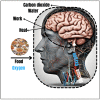Thermodynamic Analysis to Evaluate the Effect of Diet on Brain Glucose Metabolism: The Case of Fish Oil
- PMID: 38474759
- PMCID: PMC10934698
- DOI: 10.3390/nu16050631
Thermodynamic Analysis to Evaluate the Effect of Diet on Brain Glucose Metabolism: The Case of Fish Oil
Abstract
Inefficient glucose metabolism and decreased ATP production in the brain are linked to ageing, cognitive decline, and neurodegenerative diseases (NDDs). This study employed thermodynamic analysis to assess the effect of fish oil supplementation on glucose metabolism in ageing brains. Data from previous studies on glucose metabolism in the aged human brain and grey mouse lemur brains were examined. The results demonstrated that Omega-3 fish oil supplementation in grey mouse lemurs increased entropy generation and decreased Gibbs free energy across all brain regions. Specifically, there was a 47.4% increase in entropy generation and a 47.4 decrease in Gibbs free energy in the whole brain, indicating improved metabolic efficiency. In the human model, looking at the specific brain regions, supplementation with Omega-3 polyunsaturated fatty acids (n-3 PUFAs) reduced the entropy generation difference between elderly and young individuals in the cerebellum and particular parts of the brain cortex, namely the anterior cingulate and occipital lobe, with 100%, 14.29%, and 20% reductions, respectively. The Gibbs free energy difference was reduced only in the anterior cingulate by 60.64%. This research underscores that the application of thermodynamics is a comparable and powerful tool in comprehending the dynamics and metabolic intricacies within the brain.
Keywords: Gibbs free energy; brain ageing; brain glucose metabolism; entropy; fish oil supplementation; n-3 PUFAs.
Conflict of interest statement
The authors declare no conflicts of interest. The funders had no role in the design of the study; in the collection, analyses, or interpretation of data; in the writing of the manuscript; or in the decision to publish the results.
Figures


Similar articles
-
Long-chain n-3 PUFAs from fish oil enhance resting state brain glucose utilization and reduce anxiety in an adult nonhuman primate, the grey mouse lemur.J Lipid Res. 2015 Aug;56(8):1511-8. doi: 10.1194/jlr.M058933. Epub 2015 Jun 10. J Lipid Res. 2015. PMID: 26063461 Free PMC article.
-
Dietary L-carnitine supplementation changes lipid metabolism and glucose utilization of Rhynchocypris lagowskii fed diets with different lipid sources.Fish Physiol Biochem. 2024 Feb;50(1):77-96. doi: 10.1007/s10695-022-01166-1. Epub 2023 Jan 6. Fish Physiol Biochem. 2024. PMID: 36604356
-
Circulating polyunsaturated fatty acids, fish oil supplementation, and risk of incident dementia: a prospective cohort study of 440,750 participants.Geroscience. 2023 Jun;45(3):1997-2009. doi: 10.1007/s11357-023-00778-6. Epub 2023 Apr 12. Geroscience. 2023. PMID: 37046127 Free PMC article.
-
Effects of fish oil in parenteral nutrition.Nutrition. 2003 Mar;19(3):275-9. doi: 10.1016/s0899-9007(02)01009-2. Nutrition. 2003. PMID: 12620534 Review.
-
Evidence of the Role of Omega-3 Polyunsaturated Fatty Acids in Brain Glucose Metabolism.Nutrients. 2020 May 12;12(5):1382. doi: 10.3390/nu12051382. Nutrients. 2020. PMID: 32408634 Free PMC article. Review.
Cited by
-
Dietary Patterns, Food Intake and Health: New Evidence from Epidemiological and Genetic Studies.Nutrients. 2024 Mar 22;16(7):919. doi: 10.3390/nu16070919. Nutrients. 2024. PMID: 38612953 Free PMC article.
References
-
- Zoccoli G., Silvani A., Franzini C. Encyclopedia of Sleep. Elsevier; Amsterdam, The Netherlands: 2013. Sleep and the Peripheral Vascular System; pp. 563–567.
MeSH terms
Substances
Grants and funding
LinkOut - more resources
Full Text Sources

